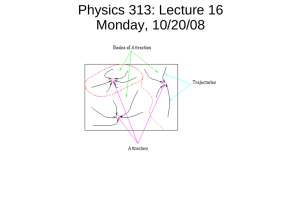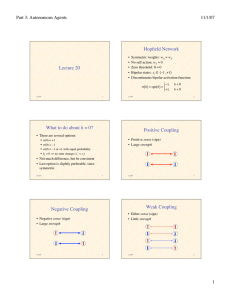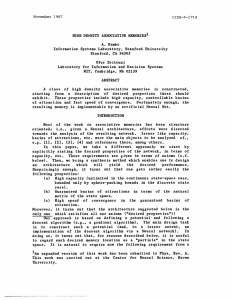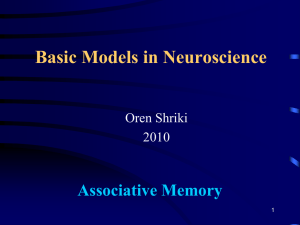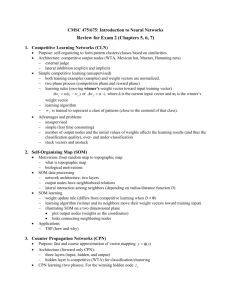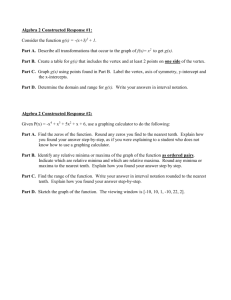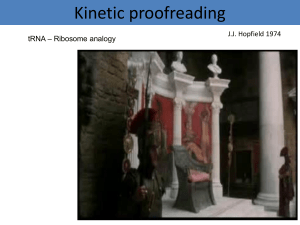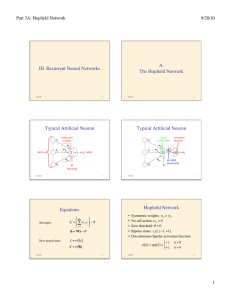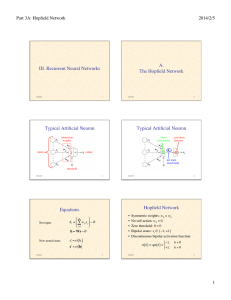notes as
advertisement
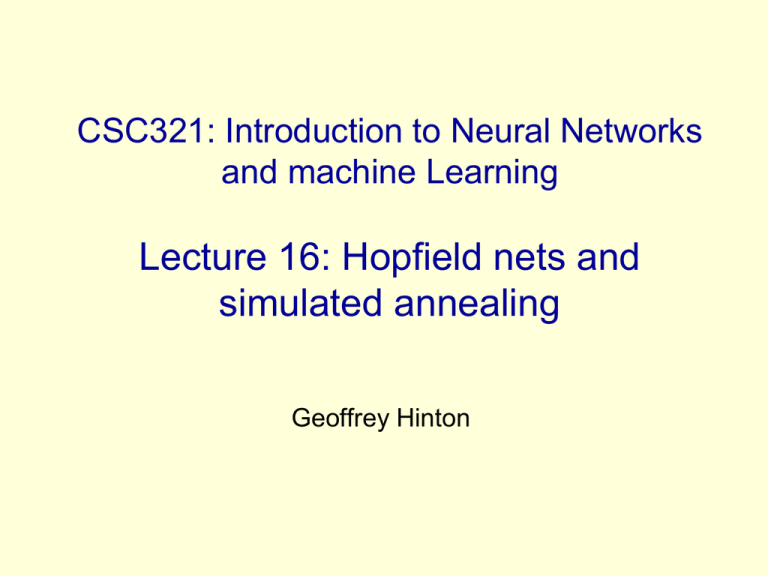
CSC321: Introduction to Neural Networks and machine Learning Lecture 16: Hopfield nets and simulated annealing Geoffrey Hinton Hopfield Nets • A Hopfield net is composed of binary threshold units with recurrent connections between them. Recurrent networks of non-linear units are generally very hard to analyze. They can behave in many different ways: – Settle to a stable state – Oscillate – Follow chaotic trajectories that cannot be predicted far into the future. • But Hopfield realized that if the connections are symmetric, there is a global energy function – Each “configuration” of the network has an energy. – The binary threshold decision rule causes the network to settle to an energy minimum. The energy function • The global energy is the sum of many contributions. Each contribution depends on one connection weight and the binary states of two neurons: E si bi i si s j wij i j • The simple quadratic energy function makes it easy to compute how the state of one neuron affects the global energy: E ( si 0) E ( si 1) bi s j wij j Settling to an energy minimum • Pick the units one at a time and flip their states if it reduces the global energy. Find the minima in this net -4 3 2 -1 • If units make simultaneous decisions the energy could go up. 0 +5 -100 3 3 -1 0 +5 How to make use of this type of computation • Hopfield proposed that memories could be energy minima of a neural net. • The binary threshold decision rule can then be used to “clean up” incomplete or corrupted memories. – This gives a content-addressable memory in which an item can be accessed by just knowing part of its content (like google) – It is robust against hardware damage. Storing memories • If we use activities of 1 and -1, we can store a state vector by incrementing the weight between any two units by the product of their activities. – Treat biases as weights from a permanently on unit • With states of 0 and 1 the rule is slightly more complicated. wij si s j wij 4 (si ) (s j ) 1 2 1 2 Spurious minima • Each time we memorize a configuration, we hope to create a new energy minimum. But what if two nearby minima merge to create a minimum at an intermediate location? This limits the capacity of a Hopfield net. • Using Hopfield’s storage rule the capacity of a totally connected net with N units is only 0.15N memories. – This does not make efficient use of the bits required to store the weights in the network. Avoiding spurious minima by unlearning • Hopfield, Feinstein and Palmer suggested the following strategy: – Let the net settle from a random initial state and then do unlearning. – This will get rid of deep , spurious minima and increase memory capacity. • Crick and Mitchison proposed unlearning as a model of what dreams are for. – That’s why you don’t remember them (Unless you wake up during the dream) • But how much unlearning should we do? – And can we analyze what unlearning achieves? Willshaw nets • We can improve efficiency by using sparse vectors and only allowing one bit per weight. – Turn on a synapse when input and output units are both active. • For retrieval, set the output threshold equal to the number of active input units – This makes false positives improbable 1 0 in 1 0 0 0 1 0 0 1 output units with dynamic thresholds An iterative storage method • Instead of trying to store vectors in one shot as Hopfield does, cycle through the training set many times. – use the perceptron convergence procedure to train each unit to have the correct state given the states of all the other units in that vector. – This uses the capacity of the weights efficiently. Another computational role for Hopfield nets • Instead of using the net to store memories, use it to construct interpretations of sensory input. – The input is represented by the visible units. – The interpretation is represented by the states of the hidden units. – The badness of the interpretation is represented by the energy • This raises two difficult issues: – How do we escape from poor local minima to get good interpretations? – How do we learn the weights on connections to the hidden units? Hidden units. Used to represent an interpretation of the inputs Visible units. Used to represent the inputs An example: Interpreting a line drawing • Use one “2-D line” unit for each possible line in the picture. – Any particular picture will only activate a very small subset of the line units. • Use one “3-D line” unit for each possible 3-D line in the scene. – Each 2-D line unit could be the projection of many possible 3-D lines. Make these 3-D lines compete. • Make 3-D lines support each other if they join in 3-D. Make them strongly support each other if they join at right angles. 3-D lines 2-D lines picture Noisy networks find better energy minima • A Hopfield net always makes decisions that reduce the energy. – This makes it impossible to escape from local minima. • We can use random noise to escape from poor minima. – Start with a lot of noise so its easy to cross energy barriers. – Slowly reduce the noise so that the system ends up in a deep minimum. This is “simulated annealing”. A B C Stochastic units • Replace the binary threshold units by binary stochastic units that make biased random decisions. – The “temperature” controls the amount of noise – Decreasing all the energy gaps between configurations is equivalent to raising the noise level. p ( si 1) 1 e 1 j s j wij T 1 1 e Ei T temperature Energy gap Ei E ( si 0) E ( si 1) The annealing trade-off • At high temperature the transition probabilities for uphill jumps are much greater. p( pick higher energy state) 1 1 e E T Energy increase • At low temperature the equilibrium probabilities of good states are much better than the equilibrium probabilities of bad ones. PA PB ( E A EB ) T e How temperature affects transition probabilities p ( A B ) 0 .2 p ( A B ) 0 .1 High temperature transition probabilities A B p ( A B) 0.001 p ( A B) 0.000001 Low temperature transition probabilities A B Thermal equilibrium • Thermal equilibrium is a difficult concept! – It does not mean that the system has settled down into the lowest energy configuration. – The thing that settles down is the probability distribution over configurations. • The best way to think about it is to imagine a huge ensemble of systems that all have exactly the same energy function. – The probability distribution is just the fraction of the systems that are in each possible configuration. – We could start with all the systems in the same configuration, or with an equal number of systems in each possible configuration. – After running the systems stochastically in the right way, we eventually reach a situation where the number of systems in each configuration remains constant even though any given system keeps moving between configurations An analogy • Imagine a casino in Las Vegas that is full of card dealers (we need many more than 52! of them). • We start with all the card packs in standard order and then the dealers all start shuffling their packs. – After a few time steps, the king of spades still has a good chance of being next to queen of spades. The packs have not been fully randomized. – After prolonged shuffling, the packs will have forgotten where they started. There will be an equal number of packs in each of the 52! possible orders. – Once equilibrium has been reached, the number of packs that leave a configuration at each time step will be equal to the number that enter the configuration. • The only thing wrong with this analogy is that all the configurations have equal energy, so they all end up with the same probability.
